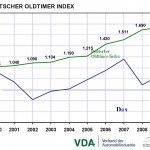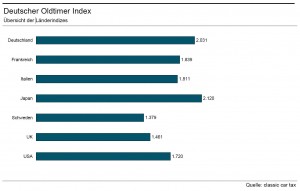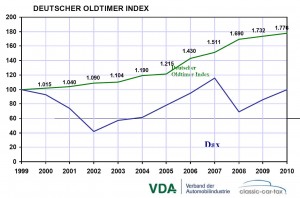
Deutscher Oldtimer Index für das Jahr 2010 – Wertentwicklung historischer Fahrzeuge bleibt verhalten
Die Wertentwicklung historischer Fahrzeuge in Deutschland bleibt verhalten. Der Deutsche Oldtimer-Index stieg 2010 um 2,5 Prozent. Auch 2009 hatte der Index nur 2,5 Prozent zugelegt. Der Index erreichte zu Jahresende 2010 einen Punktestand von 1.776. Damit hat sich die Wertentwicklung von Oldtimern in den vergangenen beiden Jahren deutlich verlangsamt. Im Oldtimer-Boomjahr 2008 war der Oldtimer-Index noch um 11,8 Prozent angestiegen. Die Wertentwicklung verläuft bei historischen Fahrzeugen darüber hinaus wesentlich gemäßigter als bei Wertpapieren. So legte der Deutsche Aktienindex DAX im Jahr 2010 mehr als sechsmal so stark zu wie der Oldtimer-Index nämlich um 16 Prozent.
 Die Liste der Fahrzeuge mit dem stärksten Wertzuwachs führt weiterhin die “Ente” (Citroën 2CV) an, gefolgt vom Fiat 500 F, der seinen Platz ebenfalls gehalten hat. Danach haben sich einige überraschende Änderungen ergeben. Der Porsche 924 liegt nun auf Platz drei, er verbesserte sich um acht Plätze. Der in den letzten Jahren stark gefragte legendäre Ferrari Dino 246 GT erfuhr dagegen eine Preisberuhigung und fiel von Platz vier auf zehn.
Die Liste der Fahrzeuge mit dem stärksten Wertzuwachs führt weiterhin die “Ente” (Citroën 2CV) an, gefolgt vom Fiat 500 F, der seinen Platz ebenfalls gehalten hat. Danach haben sich einige überraschende Änderungen ergeben. Der Porsche 924 liegt nun auf Platz drei, er verbesserte sich um acht Plätze. Der in den letzten Jahren stark gefragte legendäre Ferrari Dino 246 GT erfuhr dagegen eine Preisberuhigung und fiel von Platz vier auf zehn.
Die Länderwertung führten Fahrzeuge aus Japan an, mit 2.130 Punkten vor den deutschen Oldtimern mit einem Indexwert von 2.031 Punkten.
Der Deutsche Oldtimer Index wird alle sechs Monate vom Verband der Automobil Industrie herausgegeben. Die für die Ermittlung des Index notwendigen Daten steuert seit diesem Jahr Classic-Car-Tax aus Castrop-Rauxel bei, ein Unternehmen, welches sich auf die Erstellung von Wertgutachten für historische Fahrzeuge spezialisiert hat. Der Deutsche Oldtimer Index wird wie seit 1999 weiterhin nach den gleichen Kriterien berechnet.
 Zugrunde liegen Marktanalysen von 88 unterschiedlichen Fahrzeugtypen aus sieben Herstellernationen, die in ihrer Gesamtheit den deutschen Oldtimermarkt repräsentieren. Um eine Verzerrung durch besonders wertvolle Einzelstücke zu vermeiden, werden in der Berechung des Index keine Vorkriegsfahrzeuge berücksichtigt. Der Anfangswert im Jahr 1999 wurde auf 1.000 Punkte festgelegt.
Zugrunde liegen Marktanalysen von 88 unterschiedlichen Fahrzeugtypen aus sieben Herstellernationen, die in ihrer Gesamtheit den deutschen Oldtimermarkt repräsentieren. Um eine Verzerrung durch besonders wertvolle Einzelstücke zu vermeiden, werden in der Berechung des Index keine Vorkriegsfahrzeuge berücksichtigt. Der Anfangswert im Jahr 1999 wurde auf 1.000 Punkte festgelegt.
—–
english translation by ACI-D Stephan Joest:
Latest news from VDA, the Germany Association of the Automotive Industry, historical section:
The value growth of vintage cars in Germany rose by 2.5 percent in 2010 compared to 2009. Also 2009, the index had risen only by 2.5 percent compared to 2008. At the end of 2010, the index scored 1,776 points. This means that the performance of classic cars in the past two years slowed down significantly. In the classic car “boom” year (2008) the vintage car index still rose by 11.8 percent. The performance of vintage vehicles is rather moderate than in bonds and securities. The German stock exchange index “DAX” grew in 2010 more than six times stronger (16 percent) compared to the vintage car index.
Number one on the list of vehicles with the biggest value growth is continuing to be the Citroën 2CV, followed by the Fiat 500 F, which has kept its rank from last year. The Porsche 924 is now in third place, it improved by eight places. While in recent years, the legendary Ferrari Dino 246 GT was on position 4, now the prices have stabilized and so this car made it downwards on position 10.
Biggest growth is expected from vehicles from Japan, with 2,130 points, followed by German Classic cars with an index value of 2,031 points.
The German Classic Car Index is published every six months by the German Association of the Automotive Industry (VDA, Verband der deutschen Automobilindustrie), in cooperation with “Classic-Car-Tax”, a company specialized in creating ratings for classic cars. The German Classic Car index is still calculated as since 1999, according to the same criteria.
The data is based on market analysis of 88 different vehicle types from seven manufacturer nations, which represent in their entirety the German classic car market. To to avoid a statistical misrepresentation of the rating, the calculation of the index does not take pre-war vehicles into account because of their rather individual pricing. The initial value in 1999 was set at 1,000 points.
